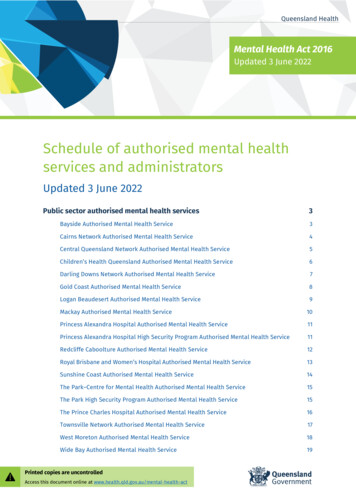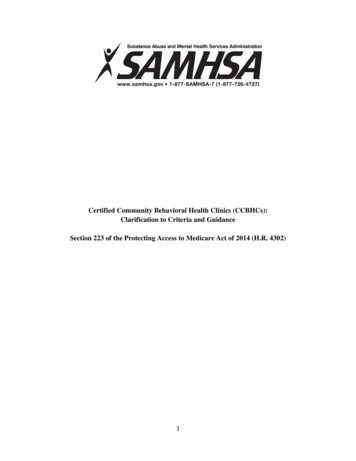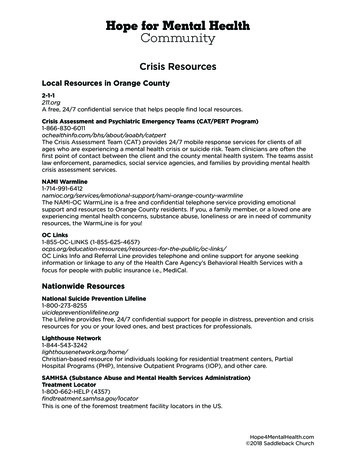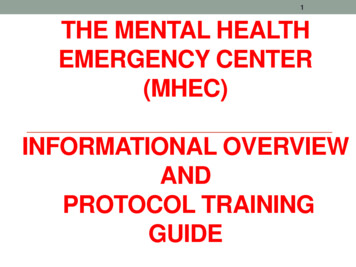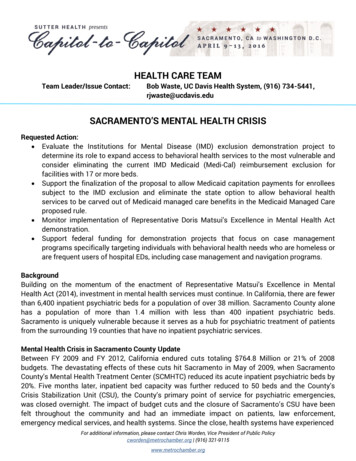
Transcription
HEALTH CARE TEAMTeam Leader/Issue Contact:Bob Waste, UC Davis Health System, (916) 734-5441,rjwaste@ucdavis.eduSACRAMENTO’S MENTAL HEALTH CRISISRequested Action: Evaluate the Institutions for Mental Disease (IMD) exclusion demonstration project todetermine its role to expand access to behavioral health services to the most vulnerable andconsider eliminating the current IMD Medicaid (Medi-Cal) reimbursement exclusion forfacilities with 17 or more beds. Support the finalization of the proposal to allow Medicaid capitation payments for enrolleessubject to the IMD exclusion and eliminate the state option to allow behavioral healthservices to be carved out of Medicaid managed care benefits in the Medicaid Managed Careproposed rule. Monitor implementation of Representative Doris Matsui’s Excellence in Mental Health Actdemonstration. Support federal funding for demonstration projects that focus on case managementprograms specifically targeting individuals with behavioral health needs who are homeless orare frequent users of hospital EDs, including case management and navigation programs.BackgroundBuilding on the momentum of the enactment of Representative Matsui’s Excellence in MentalHealth Act (2014), investment in mental health services must continue. In California, there are fewerthan 6,400 inpatient psychiatric beds for a population of over 38 million. Sacramento County alonehas a population of more than 1.4 million with less than 400 inpatient psychiatric beds.Sacramento is uniquely vulnerable because it serves as a hub for psychiatric treatment of patientsfrom the surrounding 19 counties that have no inpatient psychiatric services.Mental Health Crisis in Sacramento County UpdateBetween FY 2009 and FY 2012, California endured cuts totaling 764.8 Million or 21% of 2008budgets. The devastating effects of these cuts hit Sacramento in May of 2009, when SacramentoCounty’s Mental Health Treatment Center (SCMHTC) reduced its acute inpatient psychiatric beds by20%. Five months later, inpatient bed capacity was further reduced to 50 beds and the County’sCrisis Stabilization Unit (CSU), the County’s primary point of service for psychiatric emergencies,was closed overnight. The impact of budget cuts and the closure of Sacramento’s CSU have beenfelt throughout the community and had an immediate impact on patients, law enforcement,emergency medical services, and health systems. Since the close, health systems have experiencedFor additional information, please contact Chris Worden, Vice President of Public Policycworden@metrochamber.org (916) 321-9115www.metrochamber.org
an average of 1600 visits per month to Emergency Departments (EDs) by individuals seekingbehavioral health treatment.In response, hospitals have engaged with the community and developed pilot programs andinnovative approaches to appropriately manage patients. Despite these innovations, the influx ofindividuals seeking behavioral health care through local EDs has strained systems, resulting inprolonged wait times for patients experiencing medical emergencies, behavioral health crises, andextended ED lengths of stay for individuals requiring inpatient psychiatric hospitalization.Individuals who require acute psychiatric services are often escorted by law enforcement to hospitalEDs, where they languish for hours on gurneys, chairs, or in hallways before they are evaluated by abehavioral health clinician and transferred to an appropriate setting of care, if appropriate. The‘boarding’ of individuals requiring behavioral health treatment affects wait times for all individualsseeking medical attention and continues to impair local health systems’ ability to expeditethroughput and serve the broader community.Today, EDs continue to be the only option for individuals in mental crisis. Since the crisis began,hospitals have seen dramatic increases in the volume of patients seeking behavioral healthevaluations. Some facilities in 2015-2016 saw ED volume for behavioral health spike three times thenumber in 2007. Law enforcement wait times for behavioral health drop-offs to an ED and averagelengths of stay for individuals with behavioral health needs have also seen significant increases.Current data shows the average length of stay, from admission to discharge, for all individualsrequiring behavioral health evaluations is 19.5 hours in any Sacramento-area ED. Sacramento alsoexperiences a high percentage of individuals placed on 5150 holds (72 hour-involuntary psychiatricholds) at an average rate of nearly 57%, compared to the 14.7% national admission rate average forall ED visits in the U.S. These rates of involuntary psychiatric holds and admission are staggeringand highlight a limited ability of an ED to mitigate and manage behavioral health crises.Since 2009, the four health systems in the Sacramento Region have made significant investmentsto improve the quality of care provided to behavioral health patient populations in the acute medicalsetting and ED. These services have cost health systems and the community millions of dollarsannually to sustain, often with minimal reimbursement. Despite the millions invested to improve theevaluation and management of behavioral health patients in the ED, outcomes have been stagnantwith regard to wait times and access to appropriate, quality care. A growing body of literaturedemonstrating the effectiveness of psychiatric emergency services and crisis stabilization unitsacross the country and throughout California has driven the four health systems, the SierraSacramento Valley Medical Society, and first responders in Sacramento to build a Mental HealthImprovement Coalition to work with Sacramento County leaders to make crisis stabilization open toall individuals and law enforcement/EMS drop off the central focus of rebuilding an appropriate andadequate behavioral health system of care.For additional information, please contact Chris Worden, Vice President of Public Policycworden@metrochamber.org (916) 321-9115www.metrochamber.org
The Mental Health Improvement Coalition has produced some significant results. In September2015, the Sacramento County Board of Supervisors formally adopted their FY 2015-16 Budget,including: A 28.4 million augmentation to mental health care “rebalancing” that includes three yetto-be built 16 bed (total of 48 beds) crisis residential facilities using SB 82 funding forcapital costs; 13 million for additional staffing to expand the County’s Crisis Stabilization Unit; A County Mental Health Navigator on weekdays in several area Emergency Departments;and A 2.2 million Mental Health Mobile Community Support Team.Despite these gains, much more needs to be done to adequately address the current mental healthcrisis in Sacramento County. The Mental Health Improvement Coalition continues to work with theCounty to find workable and innovative solutions to relieve the pressure on the community and,more importantly, address the needs of patients.Institutions for Mental Disease (IMD) Exclusion DemonstrationEstablished in 1965, the Institutions for Mental Disease (IMD) Exclusion originated at a time whenstate-operated psychiatric facilities were a primary setting for behavioral health care and patientswere admitted for long-term stays. The policy prohibits federal Medicaid reimbursement forinpatient care provided to individuals between the ages of 21 and 64 in IMDs, such as private,freestanding, acute psychiatric hospitals with more than 16 beds. The lack of funding andunderpayment for behavioral health care services has led to the continual decline in the number ofinpatient psychiatric beds, thereby limiting access to care for many who suffer from behavioralhealth and substance use disorders. This exclusion has been carried forward in and applied to thenew Medicaid expansion population under the Affordable Care Act (ACA).The IMD exclusion frequently forces Medicaid beneficiaries to seek emergency psychiatric care incommunity hospitals whose emergency departments are often crowded and which may not be themost appropriate sites to handle psychiatric emergencies. Congress established the MedicaidEmergency Psychiatric Demonstration Program in 2010 to test whether allowing federal Medicaidmatching payments to freestanding psychiatric hospitals for emergency psychiatric cases wouldimprove the quality of, and access to, care and reduce Medicaid program costs. The demonstrationprovided up to 75 million over three years to enable IMDs in 11 states and the District of Columbiato receive Medicaid reimbursement for treatment of patients aged 21 to 64 who require treatmentfor psychiatric emergencies. Sacramento County is one of a few counties in California participatingin the demonstration.For additional information, please contact Chris Worden, Vice President of Public Policycworden@metrochamber.org (916) 321-9115www.metrochamber.org
We are encouraged by the preliminary data from HHS indicating that allowing such coverage isreducing utilization and lowering costs. The demonstration program was recently extended throughlegislation until HHS completes its final evaluation of the demo or until September 30, 2016,whichever occurs first, as long as the extension would not increase Medicaid costs. It also allowsthe Secretary of HHS to extend the demonstration project for additional three years and expand it toother states, subject to the same budget neutrality standard. This is critically important because ofMedicaid’s central role in covering persons with mental illness. Findings from the demonstrationproject will show eliminating the prohibition against federal payments to institutions for mentaldiseases will improve psychiatric care and reduce state Medicaid program costs. We urge Congressand CMS to continue to examine, through the Medicaid Emergency Psychiatric Demonstrationproject, whether eliminating or restricting the scope of the IMD exclusion can improve access tocare and help reduce costs.Medicaid Managed CareEnrollment in California’s Medicaid (Medi-Cal) managed care delivery system has increased from55% to 80% over the last five years by transitioning numerous populations into Medi-Cal managedcare. In June 2015, CMS proposed a rule to modernize Medicaid managed care regulations intendedto update regulations to better align them with existing commercial and Medicare Advantage rules.In the rule, CMS proposes to allow states to pay a capitation payment to managed care plans forenrollees aged 21 to 64 who are subject to the IMD exclusion, but it urges the agency to considerexpanding the 15-day limit on an enrollee’s stay. Specifically, CMS’s proposed change would allowstates to pay managed care plans for the care provided to adult enrollees who have a short-termstay of no more than 15 days in an IMD, as long as the facility is an inpatient psychiatric hospital ora sub-acute facility providing short-term crisis residential services. According to CMS, 7.1% of thoseaged 18–64 currently meet the criteria for a serious mental illness. Further, an estimated 13.6% ofuninsured adults within the Medicaid expansion population have a substance use disorder. Thesedata underscore the need to improve access to short-term inpatient psychiatric and substanceabuse disorder treatment. In addition, to further improve access to care for this vulnerablepopulation, CMS proposes to eliminate the state option to allow behavioral health services to becarved out of Medicaid managed care benefits. Such carve-out arrangements create barriers to theintegration of behavioral and physical health care and inhibit the sharing of information across caresettings.Case ManagementIt has become increasingly clear that mental health and physical health are intertwined. Manypeople with psychiatric conditions suffer from chronic health challenges. Treatment of both in acoordinated fashion is necessary for success. Less restrictive and less expensive mental healthcare options include case management programs and navigation programs to link patients withFor additional information, please contact Chris Worden, Vice President of Public Policycworden@metrochamber.org (916) 321-9115www.metrochamber.org
behavioral health needs to appropriate levels of care. Many of these programs are funded throughhospital community benefit programs and have not been integrated in reimbursement models orcare models outside of ED’s. When combined with rigorous discharge planning that connectspatients discharged from acute psychiatric facilities to outpatient services in the community, casemanagement serves as an important purpose in reducing the number of psychiatric crises that leadto recidivism. We ask Congress to study discharge planning best practices and to fund bestpractices once established.For additional information, please contact Chris Worden, Vice President of Public Policycworden@metrochamber.org (916) 321-9115www.metrochamber.org
Mental Health Crisis in Sacramento County Update Between FY 2009 and FY 2012, California endured cuts totaling 764.8 Million or 21% of 2008 budgets. The devastating effects of these cuts hit Sacramento in May of 2009, when Sacramento County's Mental Health Treatment Center (SCMHTC) reduced its acute inpatient psychiatric beds by



